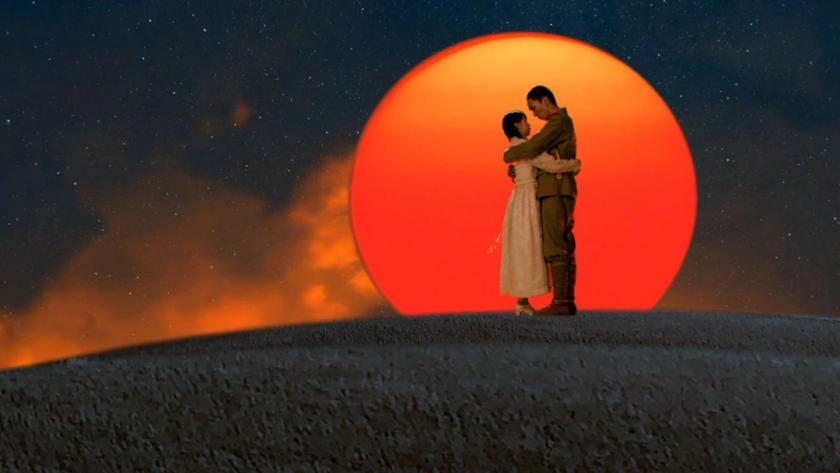The Japan Foundation Touring Film Programme runs from February 19th until March 10th, and this year focuses on the theme of ‘This is My Place’, celebrating Japanese cinema with an inspiring selection of new-releases.
Bryn Chiappe reviews Nobuhiko Obayashi’s final masterpiece and recounts the awesome confusion and appreciation for cinema that it inspires.
Nobuhiko Obayashi’s Labyrinth of Cinema is a difficult film to write a review of. It rejects any conventional approach to plot and instead takes the form of three hours of fragmented, hyper-stylised scenes with dialogue and editing of a nature that is fast-paced and frantic enough to make a Baz Luhrmann film look subdued. The anchoring of the story is an old cinema in present-day Onomichi, where Obayashi grew up, hosting its final night of screenings before closing down. The night in question is dedicated to war films and is attended by film buff Mario (Takuro Atsuki), history nerd Hosuke (Takahito Hosoyamada), Yakuza-wannabe Shigeru (Yoshihiko Hosoda), and regular of the cinema, Noriko (Rei Yoshida).
Indicative of Obayashi’s admirable disregard for orthodox storytelling structures, the film begins with quotations from the poet Chuya Nakahara and is immediately followed by a deeply surreal scene featuring Fanta G. (Yukihiro Takahashi of Yellow Magic Orchestra) on a spaceship. Fanta G. returns to us in the cinema before the lights come down, and offers some narration over the following two and a half hours at intervals so erratic that it’s hard to tell whether they are used as devices for deliberately disorientating the audience further, or whether their placement was totally arbitrary. The films begin and we realise that the characters will be participants in them, rather than observers. Noriko cries out that she wants to see war films, and instantly takes the stage to perform an old Hollywood musical-style number, performing a song to which the only lyric is ‘happy ending’. This punctuates the narrative, reappearing at moments which are equally as surprising as Fanta G.’s commentary.

I really struggled with the beginning of Labyrinth of Cinema. From my perspective as a diligent young review-writer, I felt compelled to follow my standard process of noting down the plot points as they happened alongside any interesting ideas that came to mind. Filling two pages of my notebook after only ten minutes with jottings that amounted to little more than a desperate attempt at keeping up with the images in front of me, I realised that trying to watch this as a conventional film was a road to frustration and disappointment). The amount of information that Obayashi puts across within a couple of minutes is enough to fill an entire act of a slow-paced film, and the majority of this material is of absolutely no significance to understanding any messages being conveyed by the work as a whole.
Eventually, I had a strange moment of locking eyes with Hosuke, frantically scribbling historical observations into his little red notebook as he is transported from film to film and recognised that the look of bewilderment in his eyes was present on my face too. I closed my notebook and put my hands behind my head, opting for the approach of viewing the film for a general sense of feeling, rather than a desire to understand what I was seeing. This proved to be far more pleasurable. Obayashi’s approach to surrealism is a strange one. While he avoids a head-first plunge into the nonsensical a la David Lynch, he favours the same subversion tactic of deploying film grammar to the extent of the hyper-pastiche while keeping the content of the story in the realm of the bizarre and seemingly unrelated episodic format. It makes for infuriating viewing if one is hoping for a cohesive story, but quite a compelling feeling of emotion if the audience allows themselves to be swept along by the insanity.

It would be incorrect to portray the film as being void of meaning. The title is an apt one for capturing the sense of aimlessness that can sometimes become pervasive but is more relevant to the fact that the film in engaged in a struggle to find a path through a dark expanse of twists and turns, hoping to plot the map of the labyrinth and thereby make sense of it. The labyrinth of this metaphor is Japanese history, examined in this case through its major military conflicts since the civil war of 1868-9. The characters of the film lose their identities in the cinema, becoming characters on the screen in films that cast them as everything from soldiers to actors across the history of these conflicts. As the film progresses further into the wormhole of trying to plot, and perhaps thereby reconcile, Japan’s violent history as an imperial power, the cinema itself is visited less and less. Think of it as the light from the entrance to the labyrinth growing dimmer as one ventures further in. The scenes begin to take on a more earnest tone with tragic effect as the scale of the loss of life from war begins to become comprehensible.
It’s admirable that the film sets its sights narrowly on Japan and Japan alone, refusing to attempt a detailed examination of the politics surrounding each country Japan has gone to war within an effort that would clearly have diluted the potent message. This is not to say that the USA dropping the atomic bombs on Hiroshima and Nagasaki is portrayed as anything short of the brutal murder of innocent citizens that it clearly was, but that the focus here on the impact of war on Japanese society, and the domestic desire for it that put so many in graves before their time. Pacifism isn’t merely a knee-jerk reaction to Obayashi; his lifelong commitment to opposing violence permeates the work even during its moments of silliness and the entire work’s conceptual underpinning being of such earnest passion is palpable throughout. The film is not merely plotting history, it is interrogating and correcting it. The evils of imperialism and misguided nationalism are attacked with vigour, and the viewer reaches the end of the three hours moved by the passion with which the film demands a country’s reckoning with its own past in the hope of creating a better future. It’s a timely issue to be discussing – the Japanese government historically haven’t apologised for or even acknowledged war crimes, but this film seems to be inserting itself as a form of recompense and reflection at a time when Japan is beginning to once again increase its efforts at militarism.

In 2016, Obayashi was diagnosed with stage-four terminal cancer. He received treatment throughout the process of making Labyrinth of Cinema, his second work following the diagnosis after completing Hanagatami (2017). It’s deeply touching to note that his final film was one so impassioned, and one that is ultimately a love letter to life. The cinema that the film is centred around being on its closing night feels like an appropriate case of a director’s cameo, in this case, a metaphorical one. The characters step inside the cinema unaware of the odyssey they are embarking on and leave as positively changed versions of their former selves, especially in the case of Shigeru, who has turned from gangster to monk (complete with a shaved head) over the course of the evening. In much the same way as this impactful last hurrah, it feels like Obayashi created a film that pushes his signature style to its utmost extent, and allows for the viewer to spend three hours inside his mind that are just as chaotic, joyful, tragic and bold as he was. While I don’t plan to become a monk just yet, I nonetheless feel glad to have spent some time exploring Obayashi’s imagination and look forward to getting lost in the labyrinth of work produced over his six-decade career.
Thank you for the films, Obayashi. I hope you were right when you wrote that “movies can change the future if not the past”.
Rest in peace Nobuhiko Obayashi (9 January 1938 – 10 April 2020)




